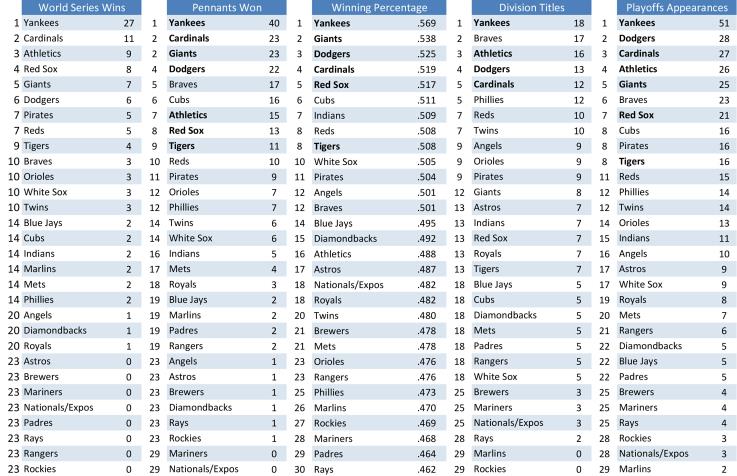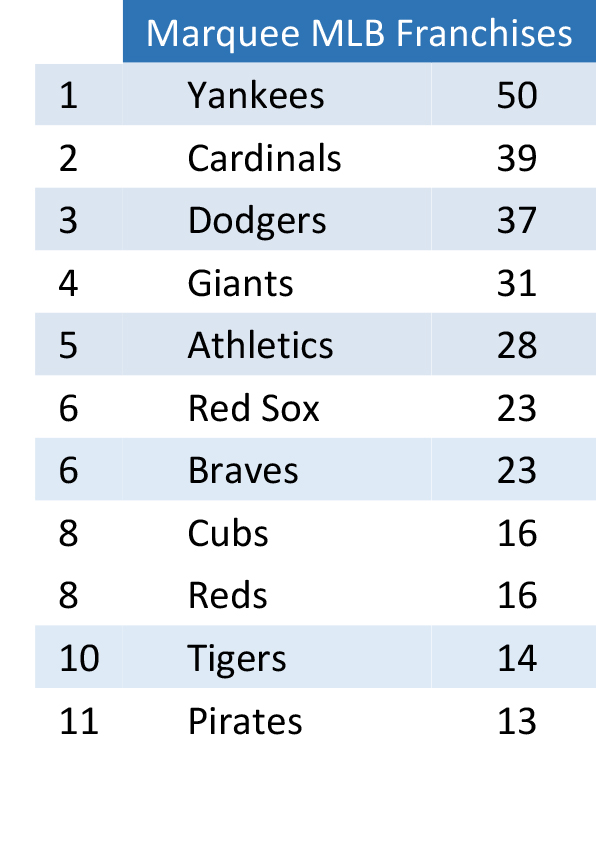



© 2014 Robert McKercher. All rights reserved.

Considering the Major League Baseball A-List

With the 2014 San Francisco Giants winning the team’s third World Series in five years and adding another chapter to the franchise’s storied history, it started me wondering whether my perceptions and the statistical record agreed on Major League Baseball’s marquee franchises. Instinctively, I think of franchises with sustained cross-generational success across the decades – teams like the Yankees, Dodgers, Cardinals, and Giants. Since the goal of every team is to win, I spent the morning at Baseball-Reference.com looking at franchise winning percentages, World Series championships, pennants, division titles, and playoffs appearances. Admittedly, this is only one, imperfect measure, but I think the high-level picture presented is accurate. For the most part the leaders in these categories are the teams I expected to be on baseball’s A-list; however, there were a few surprises and oddities.
Of course, MLB’s premier franchise is the Yankees. New York was number one in all five categories. The Bronx Bombers have appeared in 40 of the 110 World Series played, winning 27 times. Since 1923, the Yankees have won at least one World Series in every decade except the 1980s and the 2010s. Only two other franchises appeared in the top ten of each category: the Cardinals and Dodgers. The Giants are one of five teams in the top ten of four of the five categories. The others are the Athletics, Red Sox, Tigers and Braves.
To go a little deeper, I assigned points – MVP voting style – for each spot in the top ten in every category. A number 1 ranking was worth 10 points, a number 2 worth 9 points, etc. Here, in the chart at right is the baker’s top ten using that method.

All of the teams after the top four are interesting.
I think the Red Sox and Cubs would be on most people’s “intuitive” list of elite clubs. Even when times have been tough, Boston’s and Chicago’s stature has been sustained by the mystique of curses, historic ballparks, and rivalries with the Yankees and Cardinals.
The Athletics’ ranking might surprise some. Despite a .488 franchise winning percentage (thanks largely to a dismal stretch from 1934 to 1969), the A’s have enjoyed dominant periods in at least four decades; and they’ve been competitive in the 21st century.
The other franchises’ claims to elite status feel a little more tenuous to me. The once proud Pirates just ended a streak of 20 consecutive losing seasons in 2013. On the flip side, the Braves’ success (outside of the Warren Spahn/Hank Aaron years in Milwaukee) is concentrated in the last 20 years. It’s been a long time since the Nasty Boys, and even longer since the Big Red Machine, won it all in Cincinnati. Detroit has appeared in World Series in the 1900s, 1930s, 1940s, 1960s, 1980s, 2000s, and the 2010s, but it seems as though the Tigers are either great or bad, with little in between.
Some other observations:
- Eight of the top ten pennant winners have more pennants than division titles. Almost exclusively, that is because they won a significant number of pennants before the introduction of divisions. The Braves have the same number of each, and the Athletics have one more division title than pennant.
- Since the beginning of divisional baseball in 1969, every existing MLB franchise has appeared in the playoffs at least twice.
- Even with the expansion of the playoffs due to the introduction of multiple divisions and wild cards, the Angels are the only expansion era club with double digit playoff appearances.
- After winning 98 games in 2014, the Angels increased the franchise’s winning percentage to .501, becoming the only expansion era franchise with a .500 winning percentage.
- The Indians have the seventh best franchise winning percentage (.509) despite being the laughing stock of baseball for 30 years (see the movie Major League). In other words, when they’ve been good, they’ve been really good. The Indians have 36 seasons in which the team won at least 55% of its games, 10 seasons of at least .600 ball; and the 1956 team won 72% of its games. The Indians also have stretches of seven (twice), eight, and 10 consecutive seasons with winning records: 1917-1923 (.557), 1934-1940 (.551), 1947-1956 (.602), and 1994-2011 (.552).
- Maybe things aren’t so bad for Diamondbacks fans after all, despite their dismal 2014 season and a wildly inconsistent decade. Arizona won the World Series in 2001, something eight franchises have never done. The D-Backs have a higher winning percentage (.492) than the Orioles (.476) or Phillies (.473); and in only 17 seasons, they have won more division titles and playoff appearances than 1960s expansion teams the Brewers, Nationals, and Mariners.